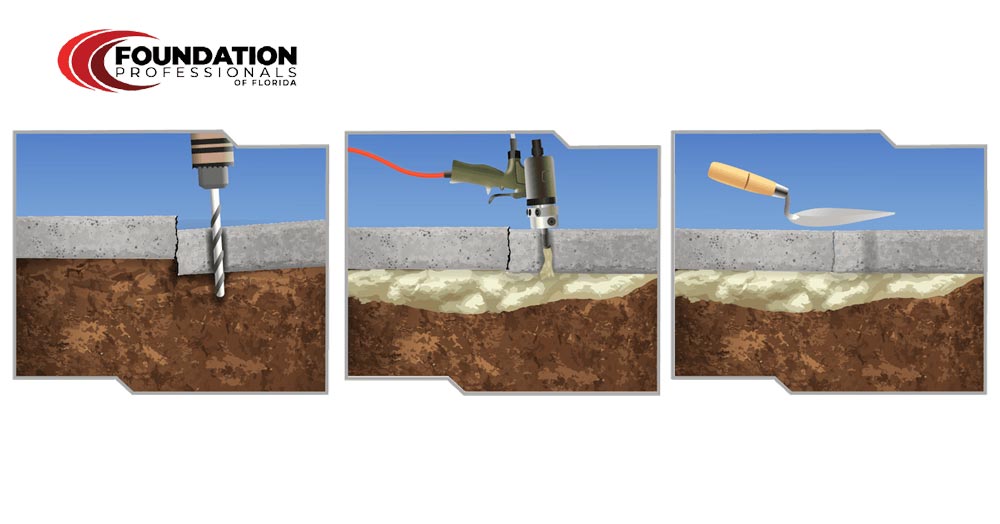Polyurethane Grouting
Polyurethane grouting involves the injection of single or multi-component polyurethane grouts into the soil to lift sunken concrete slabs, fill voids, stabilize soils, and to stop water inflow into subgrade structures such as basements, manholes and sewer lines.
Polyurethane foam was first invented in the late 1930s in Germany and has since been adapted into use extensively in the construction world. Popular uses of polyurethane grouts include slab lifting/releveling, void filling in rock or soil, soil stabilization and strengthening, for waterproofing basements, tunnels, manholes, and reducing infiltration and inflow into sewer systems.
Polyurethane grouts come in a wide variety with different viscosities, reaction times, reactions with water, flexibility when cured, expansion characteristics, and more. Polyurethane grouts can be either single or multi-component and can react into a structural foam or into a water-absorbing gel. The exact technique used depends on soil conditions and project goals.

Common uses for polyurethane grouting:
- Lift/re-level concrete slabs
- Fill voids
- Stabilize soils
- Form watertight seals around manholes and sewers
- Waterproofing underground structures
- Stop gushing leaks in underground structures
- Target Grout Injection (TGI)
Slab lifting with polyurethane foam
A very popular application for polyurethane foam is to lift and re-level sunken concrete slabs (slab jacking). By drilling holes through the slab and injecting the expanding foam, slabs are accurately lifted back to their original grade. If deep, loose soils are to blame for the slab settlement, the compaction grouting should be performed prior to completing the slab lift. After the slab is lifted, the holes are cleaned and patched with a cementitious or high strength epoxy grout. After polyurethane foam injection, sunken driveways are ready for vehicular traffic immediately due to the fast reaction and curing time of the structural foam.
Polyurethane grout for void filling
Polyurethane grouts are a lightweight, high capacity, and environmentally safe option for filling underground voids. As compared with cement grout for void filling, the lightweight nature of polyurethane foam minimizes the potential for additional sinking/settling (heavy cement may sink/settle further into the soil with time).
Soil stabilization with polyurethane grouts
Injecting polyurethane resins and gels into loose soils, voids, pores, and fissures increases strength, stiffness, solidifies and provides watertight encapsulation. There are a variety of polyurethane grouts ranging in viscosity, reaction time, reaction with water, expansion characteristics, and flexibility of cured grout to match the soil conditions as well as project objectives.
Reduce I&I into manholes and sewer lines with polyurethane grouting
Polyurethane curtain grouting has proven to be a highly effective means to control inflow and infiltration into manholes and sanitary sewer systems. Polyurethane grouts can be injected directly through the walls of manholes and sewer structures forming a watertight barrier between the soil and structure. This minimizes/reduces the potential for groundwater to make contact with the sewer pipes or structures.
Waterproofing basements, tunnels and other underground structures
Using the curtain grouting or probe grouting method, polyurethane grouts can be used to create a watertight barrier between groundwater and underground structures. By drilling holes through the walls and/or floors and injecting a polyurethane gel or foam, a watertight barrier is created, minimizing groundwater from making contact with the structure.
Stop gushing leaks (up to 15,000 GPM) with polyurethane grouts
Polyurethane grouts have been used to stop active, gushing leaks in tunnels up to 15,000 gallons per minute. High-pressure pumps and highly expansive two-part expanding polyurethane foam can be used to quickly inject and seal off high volume leaks. Once the stream is reduced significantly, hydrophilic polyurethane gels can be used to seal the remaining leaks and complement the existing foam.
Advantages of polyurethane grouts:
- Lightweight
- High-Capacity
- Non-Invasive
- Accurate Lift
- Waterproof
- Fast Cure Time
- Environmentally Safe
- Target Grout Injection (TGI)
Hydrophilic vs Hydrophobic
Hydrophilic is derived from the Latin, with “hydro” meaning “water” and “philic” meaning loving. So hydrophilic grouts “love” and actively seek out and react with water creating a tight bond with wet concrete. Hydrophilic chemical grouts can produce either closed-cell foam or non-cellular gel when mixed with water. When activated, foams can expand to 5-8 times their volume.
Hydrophobic is just the opposite of hydrophilic. Hydrophobic means “water-fearing”. A hydrophobic polyurethane grout pushes water away further into the substrate as it makes contact – creating an impermeable mass of soil-grout. Hydrophobic polyurethane grouts require a catalyst to be mixed into the resin prior to injection. The measure of catalyst mixed in controls the expansion speed and volume – using the maximum ratio of catalyst (10% by volume) the foam can expand to 29 times in volume in just 10-12 seconds.
Foundation Professionals of Florida has used polyurethane grouts on small residential slab lifting and basement waterproofing projects to large sewer structure grouting and soil stabilization projects. We service 9 states including Florida, Georgia, Alabama, Mississippi, South Carolina, North Carolina, Tennessee, Kentucky, Virginia as well as the Virgin Islands and the Florida Keys.
With over 40 years of experience and multiple awards as a geotechnical contractor – we welcome the opportunity to bid on your next project requiring polyurethane grouting. Contact us today for a free estimate.
FAQS
What is polyurethane grouting?
Polyurethane grouting is a unique injection process used to stabilize and repair weak soil. It has excellent compressive strength, stabilizing soil and supporting structures even in extreme conditions.
Polyurethane grouting has several advantages over other soil stabilization methods. It’s fast, efficient, and non-invasive. This material is exponentially lighter than alternative soil stabilization methods. It can be used in areas with limited accessibility or where excavation isn’t ideal. Polyurethane grouting is also environmentally friendly, as it’s non-toxic.
How effective is polyurethane grouting?
Polyurethane grouting effectively treats various soil conditions and structural issues, such as settlement, voids, cracks, leaks, and erosion. The foam-like material expands and hardens quickly, forming a solid, waterproof barrier that can resist water infiltration.
How long does polyurethane grouting last?
The lifespan of polyurethane grouting varies depending on various factors, including the application, the environment, and the quality of the material used. Generally speaking, polyurethane grout can last anywhere from 10 to 25 years or more, depending on these variables.
How strong is polyurethane foam?
Polyurethane foam is very strong and exhibits excellent load-bearing capacity, which makes it suitable for use in a wide range of applications that require robust and sturdy materials.

